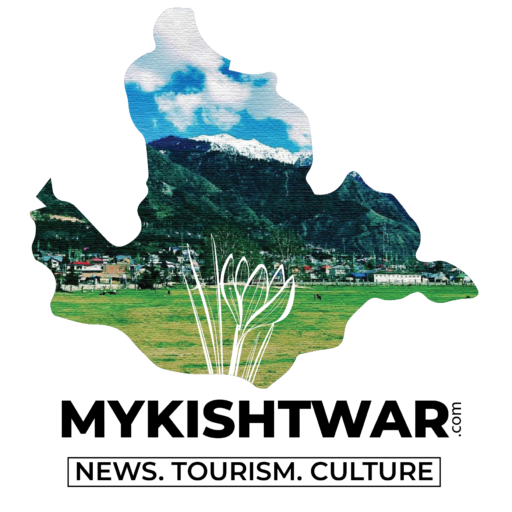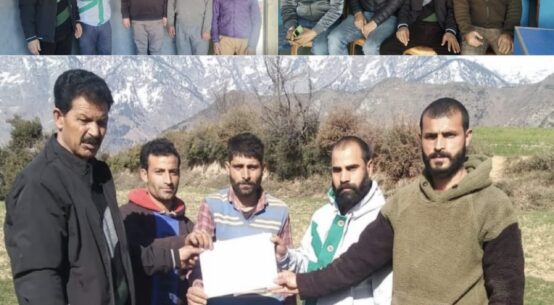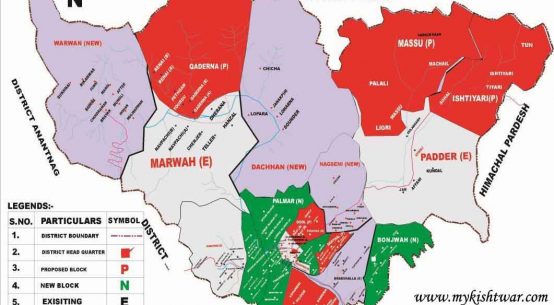
The Padder Valley is also known as the Machael Valley to some, named after the first settler called Mahu but also the name of one of the largest upstream villages. When Mahu settled the valley and where he was originally from are unknown. What is known is that each major ethnic group has its own immigration time line and story, most being relatively recent.
As best we can tell, the Padder Valley was relatively unsettled five hundred years ago. About 200 years ago in the 1830s, information improves as General Zorawar Singh came to Gulabgarh, then known as Chattergarh, named after the Himachel Pradesh raja. The victorious general changed the village name in honor of his raja, Raja Gulab Singh of Jammu (more on Zorawar Singh and his conquests and expedition across the Omasi-la pass). During the time Zorawar Singh marched his army up the Padder Valley to Machael and over the pass, 500 families are mentioned as living in the valley, which loosely translates as about 3,000 people, given an average family unit of six people. During this time, no Muslims lived in the valley. Muslims arrived approximately sixty years ago, coming from Kishtwar. Muslims settled Kishtwar from areas further to the west, as Syed Ghulam Nabi, a Sufi holy man from Kijaie, recounts of his dynasty:
Meena the dynasty of the last prophet Mohammed has come from Mecca to Medina. After some time, so many of the syeed dynasty did live in Kufa, then some of them in Baghdad. Then some of them in Lahore. From Lahore their grandfathers did come to Kashmir with Syed Mir Ali Humdany in the period of Amir-e-Taimur and Amir-e-Kabir, the Emperor of Iran and India.”
Today, Muslims have settled the valley only in the lower reaches, with Kijaie and Atholi being the furthest settlements. With larger families, however, their population has been rapidly expanding over the last century. At the same time, however, Muslim Gujjars use the high elevation summer pastures before returning to Jammu in the autumn. When the Gujjars began to use these pastures is unknown.
Therefore, the valley villagers throughout most of recorded and unrecorded human settlement were all Animist, Hindu, and Buddhist (with some overlap). Buddhists settled the upper elevations and arrived across mountain passes from Ladakh and Zanskar, but also as far as eastern Tibet in the case of Guru Choing Dorje Rinpoche, who founded the Sanga Choling Gonpa in Haloti Village 80 years ago. Samtan Chosphel, the temple caretaker, is now 81 years old and tells of an older, smaller temple being here as well as Naropa coming to the valley 1,000 years ago. Still, a century ago, the villages had as many households as today, the elders would tell you. Communication, marriage, and trade continued throughout this time with Zanskar, and still continues today. The time when the Buddhists originally settled the upper valley is unknown, but what is know is that they began to emigrate down to Gulabgarh this century, with 500 Buddhists (50% of population; 70-80 families) now residing in town, with 30 to 50 percent of families having at least one government employee.
Remains of ancient springs with stone carvings and trailside carvings are also clues to past settlements. Villagers say these spring carvings come from the Pandavas, during times of the Vedas and epics. The wear on the durable rock testifies to old age, though how old? In mountain areas of the nearby Indus River Valley, ancient cave settlements are thousands of years old. As caves in the Padder Valley have likely not been surveyed and prehistoric homes were likely built with wood and earth, concrete evidence is not likely in the near future. What can be speculated, given the movement of people, is that these remote valleys were explored, perhaps sparsely settled during ancient times, as the glaciers of the Himalayas retreated following the ice age.
Most villagers do not remember where their ancestors came from; at some point the stories have been lost. we can trace the construction of the Machael Temple back 500 years, to the story when Desraj ji’s forefathers were first given darshan by Chandi Matha, the temple goddess. Some unverified stories trace many of the villager’s roots to Rajasthan, perhaps two or three hundred years ago. A look at the people also shows the potential diversity of their roots.
As best we can tell, the Padder Valley was relatively unsettled five hundred years ago. About 200 years ago in the 1830s, information improves as General Zorawar Singh came to Gulabgarh, then known as Chattergarh, named after the Himachel Pradesh raja. The victorious general changed the village name in honor of his raja, Raja Gulab Singh of Jammu (more on Zorawar Singh and his conquests and expedition across the Omasi-la pass). During the time Zorawar Singh marched his army up the Padder Valley to Machael and over the pass, 500 families are mentioned as living in the valley, which loosely translates as about 3,000 people, given an average family unit of six people. During this time, no Muslims lived in the valley. Muslims arrived approximately sixty years ago, coming from Kishtwar. Muslims settled Kishtwar from areas further to the west, as Syed Ghulam Nabi, a Sufi holy man from Kijaie, recounts of his dynasty:
Meena the dynasty of the last prophet Mohammed has come from Mecca to Medina. After some time, so many of the syeed dynasty did live in Kufa, then some of them in Baghdad. Then some of them in Lahore. From Lahore their grandfathers did come to Kashmir with Syed Mir Ali Humdany in the period of Amir-e-Taimur and Amir-e-Kabir, the Emperor of Iran and India.”
Today, Muslims have settled the valley only in the lower reaches, with Kijaie and Atholi being the furthest settlements. With larger families, however, their population has been rapidly expanding over the last century. At the same time, however, Muslim Gujjars use the high elevation summer pastures before returning to Jammu in the autumn. When the Gujjars began to use these pastures is unknown.
Therefore, the valley villagers throughout most of recorded and unrecorded human settlement were all Animist, Hindu, and Buddhist (with some overlap). Buddhists settled the upper elevations and arrived across mountain passes from Ladakh and Zanskar, but also as far as eastern Tibet in the case of Guru Choing Dorje Rinpoche, who founded the Sanga Choling Gonpa in Haloti Village 80 years ago. Samtan Chosphel, the temple caretaker, is now 81 years old and tells of an older, smaller temple being here as well as Naropa coming to the valley 1,000 years ago. Still, a century ago, the villages had as many households as today, the elders would tell you. Communication, marriage, and trade continued throughout this time with Zanskar, and still continues today. The time when the Buddhists originally settled the upper valley is unknown, but what is know is that they began to emigrate down to Gulabgarh this century, with 500 Buddhists (50% of population; 70-80 families) now residing in town, with 30 to 50 percent of families having at least one government employee.
Remains of ancient springs with stone carvings and trailside carvings are also clues to past settlements. Villagers say these spring carvings come from the Pandavas, during times of the Vedas and epics. The wear on the durable rock testifies to old age, though how old? In mountain areas of the nearby Indus River Valley, ancient cave settlements are thousands of years old. As caves in the Padder Valley have likely not been surveyed and prehistoric homes were likely built with wood and earth, concrete evidence is not likely in the near future. What can be speculated, given the movement of people, is that these remote valleys were explored, perhaps sparsely settled during ancient times, as the glaciers of the Himalayas retreated following the ice age.
Most villagers do not remember where their ancestors came from; at some point the stories have been lost. we can trace the construction of the Machael Temple back 500 years, to the story when Desraj ji’s forefathers were first given darshan by Chandi Matha, the temple goddess. Some unverified stories trace many of the villager’s roots to Rajasthan, perhaps two or three hundred years ago. A look at the people also shows the potential diversity of their roots.

